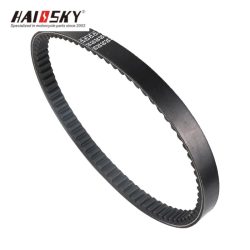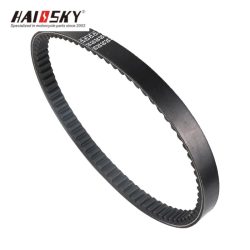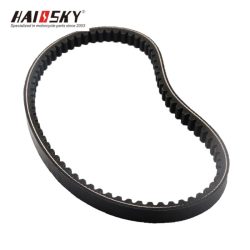OEM Motorcycle Parts
Category: Motorcycle Drive Belts - Reinforced Rubber & Kevlar
Motorcycle Belts: A Comprehensive Guide for B2B Wholesale Buyers
For wholesalers and mechanics in the motorcycle industry, understanding the role and selection of motorcycle belts is essential. These components are critical to power transmission, engine efficiency, and overall bike performance. This guide covers everything you need to know—from types and trends to maintenance and FAQs—to help you source and supply the best belts for your clients.
About Motorcycle Belts
A motorcycle belt is a flexible loop that transfers power from the engine to the rear wheel, enabling motion. Unlike chains, belts operate quietly and require minimal maintenance. They’re typically made of rubber, polyurethane, or Kevlar-reinforced materials for durability and grip. Common applications include:
Drive Belts: Connect the crankshaft to the transmission or rear wheel.
Timing Belts (Cam Belts): Synchronize the engine’s camshaft and crankshaft.
Belts are favored in modern motorcycles for their smooth operation, lightweight design, and resistance to corrosion.
Types of Motorcycle Belts
Different bikes demand specific belt types. Here’s a breakdown:
V-Belts
Design: Trapezoidal cross-section for grip in pulleys.
Use: Common in older or budget-friendly bikes.
Pros: Affordable, simple design.
Cons: Prone to stretching/slipping over time.
Cogged V-Belts
Design: Notched inner surface for reduced heat and slippage.
Use: Mid-range performance bikes.
Pros: Longer lifespan than standard V-belts.
Cons: Slightly noisier.
Synchronous (Timing) Belts
Design: Teeth on both sides for precise alignment.
Use: High-performance and electric motorcycles.
Pros: Zero slippage, efficient power transfer.
Cons: Requires precise tensioning.
Kevlar-Reinforced Belts
Design: Embedded Kevlar fibers for strength.
Use: Racing or heavy-duty motorcycles.
Pros: Handles extreme torque and heat.
Key Features and Functions
Durability: High-quality rubber or polyurethane resists wear, oil, and weather.
Noise Reduction: Operates 50% quieter than chains.
Low Maintenance: No lubrication needed, unlike chains.
Efficiency: Loses less power (2–5%) compared to chains (10–15%).
How to Choose the Right Motorcycle Belt
For B2B buyers, prioritize these factors:
Compatibility
Match belt dimensions (length/width) to the bike’s make/model (e.g., Harley-Davidson® Fat Boy uses a 118-tooth belt).
Material
Rubber: Budget-friendly, suits commuter bikes.
Polyurethane: Lightweight, ideal for sport bikes.
Kevlar: Premium choice for high-stress applications.
Application
Commuting: Standard V-belts or cogged belts.
Racing: Kevlar or synchronous belts.
Brand Reputation
Trusted manufacturers like Gates® or Bando® ensure reliability.
Cost vs. Lifespan
Kevlar belts cost 2x more but last 3x longer than rubber.
Maintenance and Replacement Guidelines
Signs of Wear:
Cracks, fraying, or glazing on the belt surface.
Chirping noises during acceleration.
Visible debris (oil, dirt) embedded in the belt.
Replacement Intervals:
Drive Belts: 15,000–30,000 miles.
Timing Belts: 10,000–20,000 miles (or per manufacturer specs).
Best Practices:
Inspect belts every 5,000 miles.
Avoid overtightening—prevents bearing wear.
Industry Trends Shaping Motorcycle Belts
Electric Motorcycles: Demand for belts that handle instant torque (e.g., Zero Motorcycles®).
Sustainability: Recycled rubber and bio-materials reduce environmental impact.
Smart Belts: IoT-enabled belts with wear sensors for predictive maintenance.
Customization: Color-matched or branded belts for premium bikes.
Q&A: Your Top Motorcycle Belt Questions Answered
Q1: Why do motorcycles use belts instead of chains?
A1: Belts offer quieter operation, lower maintenance, and better efficiency. Ideal for cruisers and electric bikes.
Q2: How long do motorcycle belts last?
A2: Drive belts last 15,000–30,000 miles; timing belts need replacement every 10,000–20,000 miles.
Q3: What happens if a timing belt breaks while riding?
A3: Engine valves and pistons can collide, causing catastrophic damage. Replacement costs range 800–800–2,500+.
Q4: Can a timing belt last 20 years?
A4: No. Even with low mileage, rubber degrades over time—replace every 5–7 years.
Q5: How do I know if my belt needs replacing?
A5: Look for cracks, fraying, or uneven wear. Unusual noises or slipping are red flags.
Q6: What belts last the longest?
A6: Kevlar-reinforced belts (e.g., Gates® Carbon Drive®) outlast rubber by 3x.
Q7: Do Honda® belts have a different lifespan?
A7: Honda® OEM belts typically last 20,000–25,000 miles with proper care.
Conclusion
For wholesalers, stocking high-quality motorcycle belts is key to meeting client demands for reliability and performance. At HAISSKY, we supply OEM-grade belts tailored for cruisers, sport bikes, and electric models. Explore our catalog to partner with a trusted B2B supplier.
About HAISSKY: As a leading global wholesaler of motorcycle parts, we deliver durability and precision. Our belts are engineered for peak performance—connect with us for competitive pricing and bulk orders.







